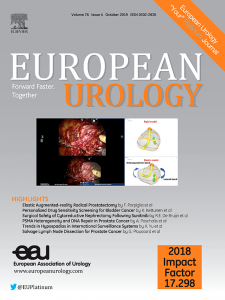Magnetic Resonance Imaging Versus Computed Tomography Guidance for Stereotactic Body Radiotherapy in Prostate Cancer: 2-year Outcomes from the MIRAGE Randomized Clinical Trial
IF 25.2
1区 医学
Q1 UROLOGY & NEPHROLOGY
引用次数: 0
Abstract
It has been shown that magnetic resonance imaging (MRI) guidance versus computed tomography (CT) guidance for aggressive margin-reduction (AMR) for stereotactic body radiotherapy (SBRT) in prostate cancer reduces acute toxicity, but the longer-term benefits are unknown. We performed a secondary analysis of MIRAGE, a phase 3 randomized clinical trial of MRI-guided SBRT for prostate cancer, to determine whether AMR with MRI guidance significantly reduced 2-yr physician-scored or patient-reported toxic effects in comparison to CT guidance. The cumulative incidence of 2-yr physician-scored toxicity, defined as grade ≥2 genitourinary (GU) and gastrointestinal (GI) toxic effects according to Common Terminology Criteria for Adverse Events v4.03, were lower with MRI guidance. Cumulative incidence rates of late grade ≥2 toxicity at 2 yr with MRI-guided versus CT-guided SBRT were 27% (95% confidence interval [CI] 19–39%)] versus 51% (95% CI 41–63%) for GU toxicity (p = 0.004), and 1.4% (95% CI 0.2–9.6) versus 9.5% (95% CI 4.6–19) for GI toxicity (p = 0.025). Cumulative logistic regression revealed that MRI-guided SBRT was associated with significantly lower odds of a clinically relevant deterioration in bowel function according to the Expanded Prostate Cancer Index Composite-26 score (odds ratio 0.444, 95% CI 0.209–0.942; p = 0.035) and in the Sexual Health Inventory in Men score (odds ratio 0.366, 95% CI 0.148–0.906; p = 0.03). There were no significant differences in the odds of a deterioration for other quality-of-life metrics. These findings support the hypothesis that aggressive planning for margin reduction for prostate SBRT using MRI leads to continued reductions in toxic effects over 2-yr follow-up.
This trial is registered on ClinicalTrials.gov Identifier as NCT04384770.
前列腺癌立体定向体部放射治疗的磁共振成像与计算机断层扫描引导:MIRAGE 随机临床试验的两年结果
研究表明,磁共振成像(MRI)引导与计算机断层扫描(CT)引导的前列腺癌立体定向体外放射治疗(SBRT)的积极边缘缩小(AMR)可降低急性毒性,但长期疗效尚不清楚。我们对 MRI 引导的前列腺癌 SBRT 3 期随机临床试验 MIRAGE 进行了二次分析,以确定与 CT 引导相比,MRI 引导的 AMR 是否能显著降低 2 年内医生评分或患者报告的毒性反应。根据《不良事件通用术语标准》v4.03,由医生评分的2年毒性反应(定义为≥2级的泌尿生殖系统(GU)和胃肠道(GI)毒性反应)的累积发生率在MRI引导下更低。2年后,MRI引导与CT引导SBRT的晚期≥2级毒性累积发生率分别为:泌尿系统毒性为27%(95%置信区间[CI] 19-39%)]对51%(95% CI 41-63%)(P = 0.004),消化道毒性为1.4%(95% CI 0.2-9.6)对9.5%(95% CI 4.6-19)(P = 0.025)。累积逻辑回归显示,根据扩展前列腺癌指数综合-26评分(几率比0.444,95% CI 0.209-0.942;p = 0.035)和男性性健康量表评分(几率比0.366,95% CI 0.148-0.906;p = 0.03),MRI引导下SBRT与临床相关的肠功能恶化几率显著降低相关。其他生活质量指标的恶化几率没有明显差异。这些研究结果支持以下假设:使用磁共振成像对前列腺SBRT进行积极的边缘缩小计划可在2年随访期间持续降低毒性反应。
本文章由计算机程序翻译,如有差异,请以英文原文为准。
求助全文
约1分钟内获得全文
求助全文
来源期刊

European urology
医学-泌尿学与肾脏学
CiteScore
43.00
自引率
2.60%
发文量
1753
审稿时长
23 days
期刊介绍:
European Urology is a peer-reviewed journal that publishes original articles and reviews on a broad spectrum of urological issues. Covering topics such as oncology, impotence, infertility, pediatrics, lithiasis and endourology, the journal also highlights recent advances in techniques, instrumentation, surgery, and pediatric urology. This comprehensive approach provides readers with an in-depth guide to international developments in urology.
 求助内容:
求助内容: 应助结果提醒方式:
应助结果提醒方式:


